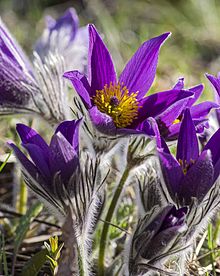Lily Valley
The Liliental is located in the Kaiserstuhl between Ihringen and Wasenweiler in Baden-Württemberg and is a forest test site that has been operated by the Forest Research and Research Institute of Baden-Württemberg (FVA) since 1958 . The valley extends northeast from the Mühlental and lies southeast below the Totenkopf .
history
According to archaeological finds, the area has long been inhabited. The Lilienhof was first mentioned in the 11th century as the property of the Lords of Üsenberg , who had the right to hunt there, as in the entire Kaiserstuhl . In 1392 the property went to the Margrave von Hachberg . He pledged it with Ihringen to his son-in-law, Count zu Leiningen . With the purchase of the Hachberg estate in 1414 by Margrave Bernhard I , Ihringen, including the Lilienhof, became margravial-Baden. The agricultural use in the Middle Ages is proven by finds of vine knives and horseshoes. After depopulation during the Thirty Years War , agricultural use was reduced and the forest reclaimed the area. In the middle of the 19th century it was used again for agriculture by the Baden Society for Tobacco Products and Trade . The Baron von Babo built the Lilienhof estate, which covers 280 hectares. This business acquired a good reputation for its wine production and horse breeding in the 19th century under August Wilhelm Julius Graf von Bismarck , a third cousin of Reich Chancellor Otto von Bismarck . After several changes of ownership, the farm was discontinued and the entire area was acquired in 1957 by the state forest administration, which handed over the 80 hectare area to the FVA.
Building history
In 1897 the Lilienhof Palace was built on the site, which has since been demolished. The complex now consists of the former courtyard complex with a central old fountain; the former main building, known as the Schlössle , was renovated in 1980. There are rooms for the forest management, a lecture hall and a restaurant.
Test site

The approx. 80 hectare area is used with its experimental areas, plantations for seed production and an arboretum for forest science . It is known, among other things, for its 1.2 hectare forest of giant sequoias and its over 20 protected native orchid species . The area in the Liliental is characterized by its loess soil , which consists of wind deposits from sand from the Upper Rhine Plain , with a high lime content and dry grass , in addition, Ihringen is climatically the warmest place in Germany. The lowest point of the terrain is the Mühlental with the Mühlenbach at an altitude of about 260 m above sea level. NHN , the highest point is the Adlernesthütte ( 420 m ) with a good panoramic view.
In addition, the Liliental is accessible all year round as a recreation area. The area is easily accessible from the central buildings, the Lilienhof, on a dead end road about three kilometers from the L 114, with a park in the style of an English garden, with its three circular trails, which are suitable for the disabled. The trails also include a three-kilometer educational trail through the arboretum.
In the spring of 2016, trees from the former linden seed plantation, cherry seed plantation and the former cherry trial were felled on almost three hectares to make room for mountain maples . The felled trees had exceeded their natural production cycle.
Arboretum
An arboretum has been set up on the test site , as well as extensive collections of native and foreign shrubs. For example, the trees in the sequoia forest were sown in the Stuttgart pheasant garden in 1956 and replanted in their current locations in 1960. In the meantime they have developed so well with heights of growth of well over 20 m that some of them have had to be removed in order not to hinder the growth of the others. One of the interesting facilities is a forest with Japanese tree species.
Web links
- The Liliental forest trial site. In: Forestry Experimental and Research Institute Baden-Württemberg (FVA). Retrieved November 20, 2014 .
- The Liliental test site of the Baden-Württemberg Forestry Test and Research Institute. (PDF; 484 kB) Flyer. Forest Research and Research Institute Baden-Württemberg (FVA), November 26, 2013, accessed on November 20, 2014 .
- Lilienhof story. In: Badische Zeitung. Retrieved November 20, 2014 .
Individual evidence
- ↑ a b Lilienhof story. In: Badische Zeitung. Retrieved November 20, 2014 .
- ↑ a b c Liliental forest test site. (PDF; 3.37 MB) Flyer. (No longer available online.) Kaiserstuhl Touristik, July 22, 2010, archived from the original on November 29, 2014 ; Retrieved November 20, 2014 .
- ↑ Joshua Kocher: Ihringen: Kaiserstuhl: Power trees are planted in the Liliental for climate change. Badische Zeitung, May 5, 2016, accessed on May 6, 2016 .
- ^ Eva Marbach: Liliental near Ihringen. In: kaiserstuhl.net. Retrieved November 20, 2014 .
- ^ The Liliental forest trial site. In: Forestry Experimental and Research Institute Baden-Württemberg (FVA). Retrieved November 20, 2014 .
Coordinates: 48 ° 4 ′ 5.3 " N , 7 ° 40 ′ 30.5" E



